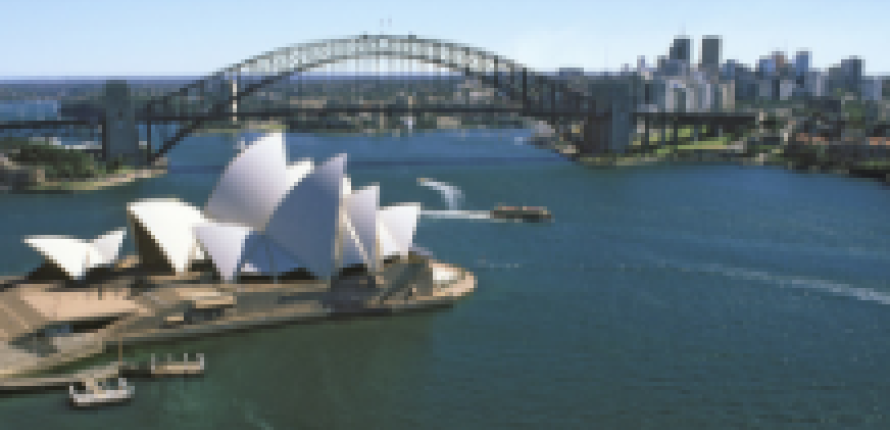Celebrating 70 Years of Fulbright Australia

As Fulbright Australia celebrates its 70th anniversary in 2019, Commission Executive Director Thomas Dougherty reflects on the opportunities available to Fulbrighters in the land down under.
A career diplomat, Mr. Dougherty served in Africa, the Middle East, Europe, Australia, and Washington. He was U.S. Ambassador to Burkina Faso from 2010-2013, and most recently served as Deputy Chief of Mission at the U.S. Embassy in Canberra from 2013-2016. As a former Fulbrighter to Indonesia and Singapore, assuming the Executive Director position with Fulbright Australia in 2016 gave him the opportunity to bring his career “full circle.”
Read on to learn more about the academic collaboration, research and exploration possibilities that await in Australia.
What advice would you give to U.S. Fulbrighters in Australia?
I give the same advice to Fulbrighters in Australia that I would in any other country: which is, while you have a wonderful opportunity to further your academic interests, this is also a once in a lifetime opportunity to explore a new country and meet people you otherwise would never encounter. Get out of the lab, get out of your classroom when you can. Maximize your time on the academic side, but know that what will last the longest are the personal and professional ties that you establish here. Say yes to everything you are invited to when you’re there. You never know whom you might meet, or where that invitation might take you.
Why should prospective Fulbrighters choose Australia?
Often, scholars and students arrive in Australia with a very definite idea of what Australia and Australians are going to be like. Yet what they discover is that Australia and Australians are as diverse as America and Americans. There are differences, of course, between the two nations, but there is immense diversity to Australia, in all respects – people, history, culture, geography – that makes it a really exciting place to visit.
From an academic perspective, Australia is quite competitive in a number of fields, and there is already a lot of existing research collaboration between the two countries. Astrophysics, quantum computing, and neurological research are just a few examples of the disciplines where there is likely to be pre-existing linkages between America and Australia. Yet I could have just as easily mentioned the arts, music, maritime science, and the environment.
We as a commission do our best to make sure that we have balance among all disciplines every year in the selection process. The Fulbright Program helps further the existing exchange of knowledge, brings people together, and solidifies established networks -- making them much more useful and sustainable in the long term.
How is Fulbright Australia celebrating its 70th anniversary?
As we at the Fulbright Australia Commission – and our board – began planning our 70th anniversary celebration, we decided to raise funds to support our work. We started with a modest goal of 3 million Australian dollars, but with some good luck and hard work, we ended up far exceeding that. Up to this point, we have raised 60 million Australian dollars, with particular support from a foundation that gave us 50 million Australian dollars – the largest gift in Fulbright history anywhere. In the first year, this allowed us to double the number of awards we give out. We will now be able to redouble our awards again. These awards are game changers, covering 100 percent of costs. So we are very excited about this.
Looking back on the last few years, what are some of the most interesting, impactful projects by scholars and students associated with Fulbright Australia?
It is hard to single out any one project over another. A strong focus of ours is to make sure that our Fulbrighters represent all aspects of diversity. This year, an Australian Fulbrighterwho is blind will be working at Harvard to develop best practices in policy and programming for access for the disabled. He will be traveling with a guide dog who, naturally, we made an honorary Fulbrighter.
Australia also recently hosted a student from Stanford University who is legally blind and working on a very interesting project at the University of New South Wales involving haptic devices enabled through an implant. Before a thought can form in the brain – such as, “oops I’m going to fall” – the device will send an electronic signal to the brain and body to prepare it – for example, to brace the body for the fall. Naturally, innovations like this have a huge impact on those who are disabled, and on the elderly.
Tell me a little bit about how you came to your role and what you enjoy about your work.
Given my career with the State Department and having been a participant myself, I’ve always been familiar with Fulbright on a micro and macro level, and I’ve always been a big promoter of the Program. So far, I’ve enjoyed everything about the position. It’s been wonderful having the opportunity to meet Australian scholars and students, establish linkages between universities in both countries, and reinforce the original intent of the Fulbright Program.
I think reinforcing Fulbright’s original message is particularly important now, 73 years into the history of the program, because the people who were around when Senator Fulbright originally established the Program are no longer around. We have undergone many generational changes since then. In light of that, it is more important than ever to emphasize the Fulbright values of facilitating people to people exchange, and take every opportunity we can to increase the size and strength of the Program.
Review all Fulbright opportunities in Australia here, Fulbright Distinguished Chair awards here, and the Fulbright Scholar Award in Resources and Energy.
